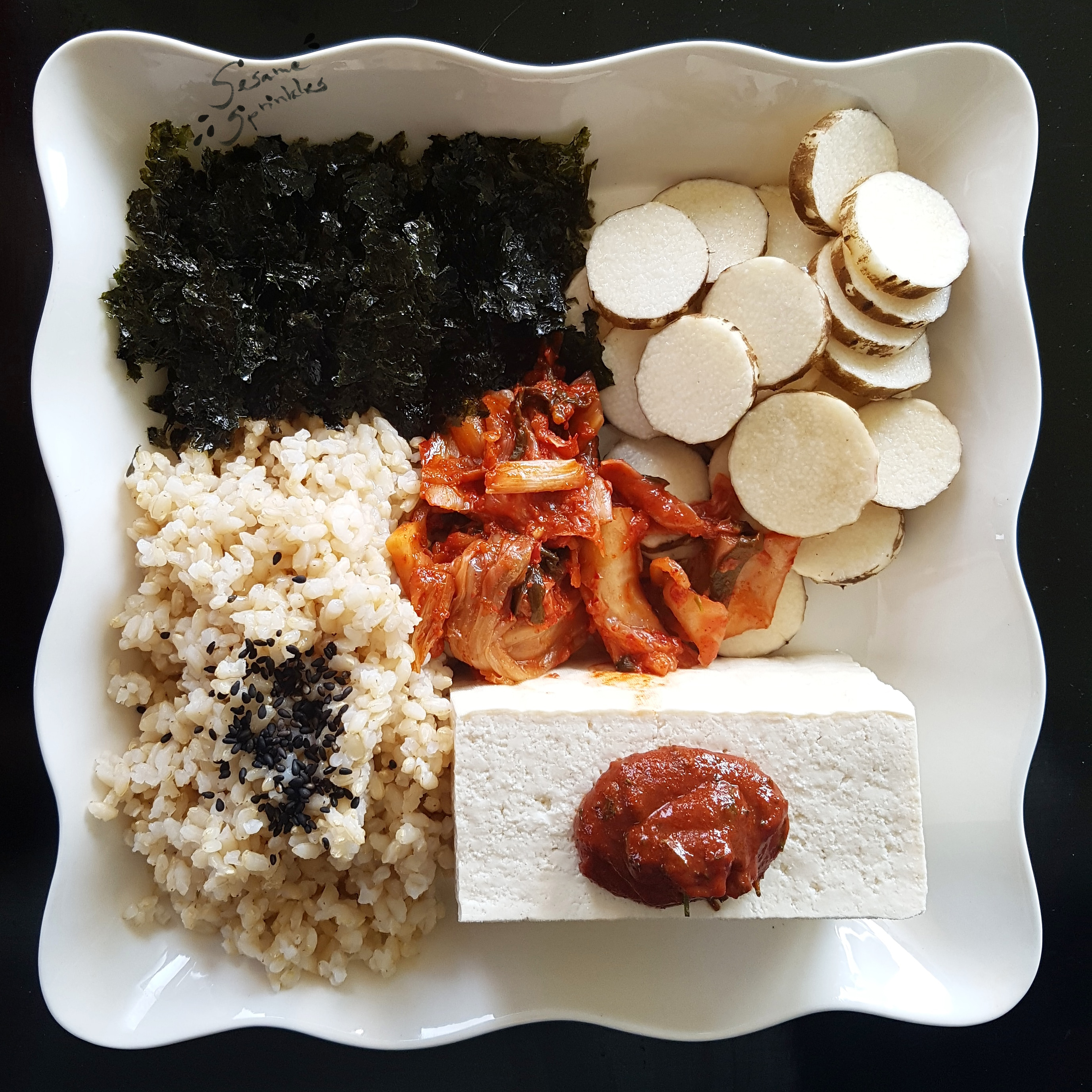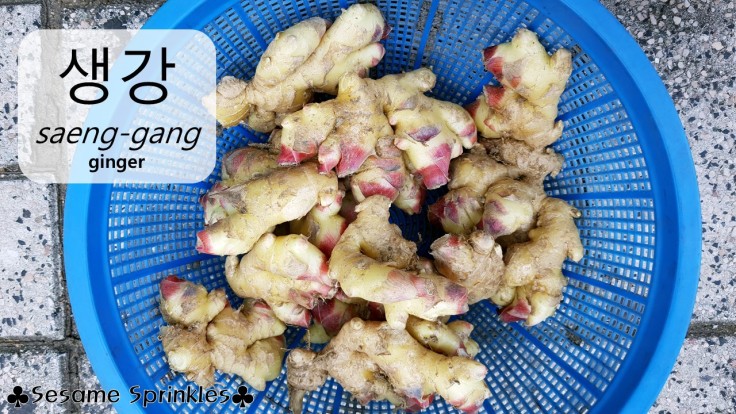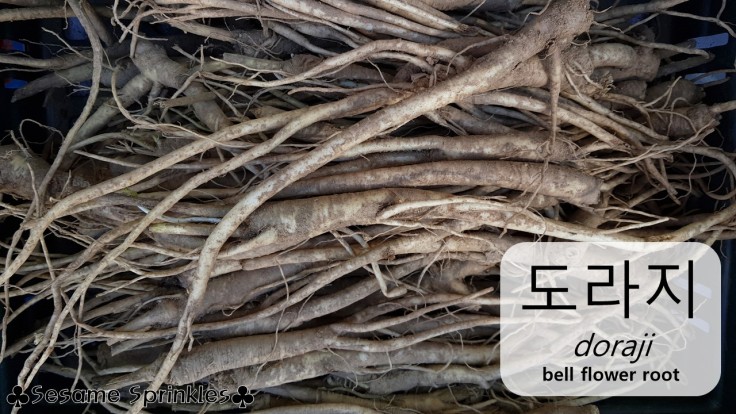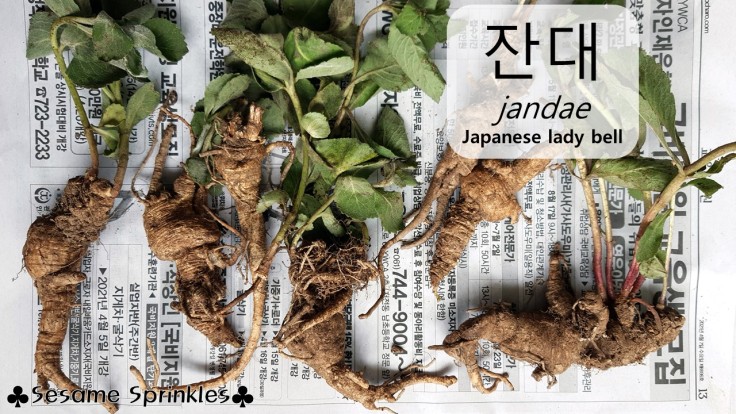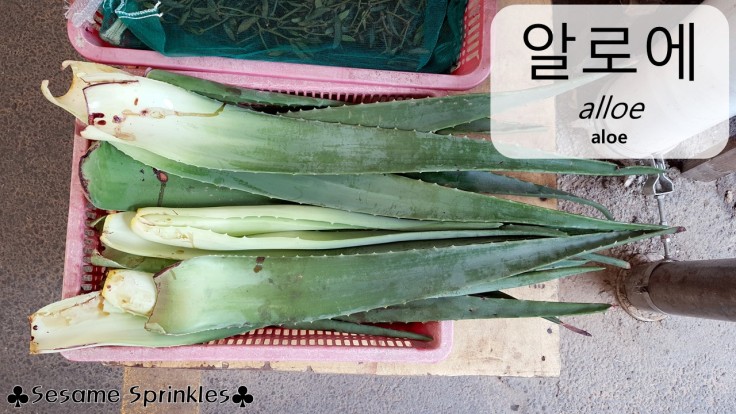Did you ever pass a Korean health food store or a street vendor selling things that are considered natural remedies? When I do, I keep wondering “What is that? Why is it sold here? What is it used for? How is that edible?” 🤔💭
One can argue about whether such components of herbal medicine can be associated with food or not. Still, many food items are ascribed medicinal properties (e.g. ginseng, jujube, ginkgo seeds). Likewise, certain ingredients are added to food or drinks because of their effects on the body – just to mention the diverse ingredients that are put into Korean ginseng chicken soup, Samgyetang (삼계탕), or the medicinal tea Ssanghwacha (쌍화차). Most medicine is, after all, consumed through the mouth and digestive system as well. So after many internal discussions [in my head], I decided to make a list about Korea’s traditional medicine and health foods. Just to help identifying them. 🔍🧐 Just to show their diversity. 🌈 Just to learn what those mysterious roots, chunks of wood and mushrooms actually are. 🕵️ Just to be able to seek out or better avoid certain ingredients. ✅🍽❌
Traditional Korean medicine is referred to as hanuiyak (한의약 韓醫藥), hanyak (한약 韓藥) or hanbang (한방 韓方). A similar concept is known as “traditional oriental medicine” or “traditional Chinese medicine” (TCM) in English. Regardless of those Western names, it has been practiced in Korea and other Asian countries for many centuries, albeit with regional differences. Korea’s traditional medicine is an alternative to modern [Western] medicine (hyeondae uihak 현대의학), and both types of medicine are respected in present South Korea. 💊 Hanyak uses herbal medicine created from natural ingredients, i.e. mostly plants, fungi, animals and minerals. Korean traditional medicine is its own field of study and it is a profession that requires many years of education and training. There are several historical resources, e.g. the Dongui Bogam (동의보감 東醫寶鑑) and the Hyangyak Jipseongbang (향약집성방 鄕藥集成方). A modern reference, which was primarily consulted here, is the online Korea Pharmaceutical Information Center.
Below word list provides names of ingredients of herbal medicine and health foods in Korean language. 🗒💊🇰🇷🇰🇵 There are hundreds of ingredients in herbology, but this list does not include all of them. Instead, you can find the most common ingredients as well as particularly curious items. [Some are not legal or not in use anymore!] In addition to that, newer health food products, including so-called superfoods, are also listed here but marked with [*] to distinguish them from the traditional ingredients. Did YOU stumble across something but cannot identify it? ❓ Let’s find out what it is! ❗️ Comment below or send me a message! [The author is no expert in herbal medicine and advice is welcome as well!]
All items are sorted into one of the following categories: Plant-based ingredients 🌱, animal substances 🦌, medicinal mushrooms as well as other life forms 🍄, and inorganic materials. 🪨 The plant elements are distinguished by what part of the plant (e.g. root, leaf, flower, seed) is used for medicine. 🥕🌿🌼🍎
Some ingredients are identical with food mentioned in previous vocabulary lists, e.g. vegetables, mushrooms, seasonings or animal-based ingredients. Note that names in traditional medicine are based on Sino-Korean characters and may deviate from names used in daily life. Common names are added in brackets behind the pharmaceutical terms – you may be familiar with them already!
Whatever theory of health and healing you may follow, it is all the more important to stay healthy in these times! Take care of your health and your loved ones! 💚
⚠️ Disclaimer: The author does not provide explanations or medical instructions for any of the mentioned items. Also, listing items does not mean that their health benefits are verified. They are listed here because they are traditionally ascribed with medicinal properties or because they are marketed as natural medicine. Note that consuming certain plants without proper knowledge can be dangerous. Please read with caution and act responsibly. ⚠️

Names of natural medicinal ingredients in Korean
Korean traditional medicine ingredients 한약재 hanyakjae
🌱 Plant-based ingredients 🌼🌿
- traditional medicine ingredients of plant origin – 식물성 한약재 singmulseong yakjae
- medicinal ingredients of natural origin – 천연 약재 cheonyeon yakjae
- medicinal plant, pharmaceutical herb – 약초 yakcho
🥕 Roots, tubers and rhizomes 🧅🍠
- 🥕 Korean ginseng, Panax ginseng (grown in agriculture) – 인삼 人蔘 insam
- ⛰️ wild ginseng (grown on mountains) – 산삼 山蔘 sansam
- 💦 fresh and raw ginseng – 수삼 水蔘 susam
- dried ginseng – 건삼 乾蔘 geonsam
- 🔴 “red ginseng” (aged ginseng, steamed and dried) – 홍삼 紅蔘 / 红蔘 hongsam
- 🥕 South China ginseng, tienchi ginseng, Chin. tiánqī 田七, sānqī (Panax notoginseng) – 삼칠 三七 samchil
- 🥕 Japanese lady bell (Adenophora triphylla) – 사삼 沙蔘 / 砂蔘 sasam [잔대 jandae / 딱주 ttakju / 제니 jeni / 잔다구 jandagu]
- 🌷 hairy asiabell, Chin. dangshen (Codonopsis pilosula) – 당삼 黨蔘 dangsam / 만삼 蔓蔘 mansam
- 🌷 lance asiabell root (Codonopsis lanceolata) – 사삼 沙蔘 / 砂蔘 sasam / 양유 羊乳 yangyu [더덕 deodeok]
- 🌷 bell flower root (Platycodon grandiflorus) – 길경 桔梗 gilgyeong [도라지 doraji]
- licorice, liquorice root (Glycyrrhiza glabra) – 감초 甘草 gamcho
- East Asian arrowroot, kudzu, Jap. kuzu (Pueraria lobata) – 갈근 葛根 galgeun [칡 chik]
- roots of red sage, Chinese sage (Salvia miltiorrhiza) – 단삼 丹參 dansam
- 🫚 ginger – 생강 生薑 saenggang
- dried ginger – 건강 乾薑 geon-gang
- 🫚 myoga, myoga ginger, Japanese ginger (Zingiber mioga) – 양하 襄荷 yang-ha [양애 yang-ae]
- 🫚 wild turmeric (Curcuma aromatica) – 울금 鬱金 ulgeum
- 🫚 turmeric, curcuma (Curcuma longa) – 강황 薑黃 ganghwang
- 🫚 (Curcuma zedoaria) – 봉출 蓬朮 bongchul
- 🥔 Chinese yam, Chin. shānyào, Jap. nagaimo (Dioscorea polystachya) – 산약 山藥 sanyak [산마 sanma]
- 🥔 topinambur, Jerusalem artichoke (Helianthus tuberosus) – 국우 菊芋 gugu [돼지감자 dwaeji gamja]
- 🥔 rhizome of Gastrodia elata – 천마 天麻 cheonma
- 🥔 rhizome of Dioscorea quinquelobata – 천산용 穿山龍 cheonsanyong / 단풍마 丹楓 danpungma
- siler (Saposhnikovia divaricata) – 방풍 防風 bangpung [not the same as the vegetable 방풍나물 bangpung-namul]
- tuber of lilyturf, monkey grass (Liriope muscari) – 맥문동 麥門冬 maengmundong
- (Asparagus cochinchinensis) – 천문동 天門冬 cheonmundong
- rhizome of Atractylodes lancea (or Atractylodes chinensis) – 창출 蒼朮 changchul
- rhizome of Atractylodes macrocephala – 백출 白朮 baekchul
- 🥕 angelica, dong quai, female ginseng (Angelica sinensis or Angelica gigantis) – 당귀 當歸 dang-gwi
- Dahurian angelica (Angelica dahurica) – 백지 白芷 baekji
- root of Solomon’s seal (Polygonatum doratum) – 옥죽 玉竹 okjuk [둥굴레 dunggulle]
- fresh root of Rehmannia glutinosa – 생지황 生地黃 saeng jihwang
- dried root of Rehmannia glutinosa – 간지황 干地黃 gan jihwang
- processed root of Rehmannia glutinosa – 숙지황 熟地黃 suk jihwang
- root of Chinese peony (Paeonia lactiflora) – (백)작약 (白)芍藥 (baek) jagyak
- root of red peony (Paeonia obovata) – 적작약 赤芍藥 jeok jagyak
- sickle-leaved hare’s-ear, Chinese thoroughwax, sickle hare’s ear, sickle-leaf hare’s ear (Bupleurum falcatum) – 시호 柴胡 siho
- (Anthriscus sylvestris) – 전호 前胡 jeonho
- notopterygium root (Notopterygium incisum or Ostericum koreanum) – 강활 姜活 gang-hwal
- (Aralia continentalis) – 독활 獨活 dokhwal [땃두릅 ttat dureup]
- outer rind of roots from Japanese elm (Ulmus davidiana var. japonica) – 유근피 楡根皮 yugeunpi [느릅나무 neureup namu]
- Bikal skullcap, Chinese skullcap (Scutellaria baicalensis) – 황금 黃芩 hwang-geum
- Mongolian milkvetch (Astragalus propinquus / membranaceus) – 황기 黃耆 / 黃芪 hwang-gi
- rhizome of Chinese goldthread, canker root (Coptis chinensis) – 황련 黃連 hwangnyeon
- root of Achyranthes – 우슬 牛膝 useul
- root of common reed (Phragmites australis) – 노근 蘆根 nogeun
- tuber of Kusnezoff monkshood (Aconitum kusnezoffii) – 초오 草烏 cho-o [선줄바꽃 seonjulba kkot]
- tuber of Chinese aconite, Carmichael’s monkshood, Chinese wolfsbane (Aconitum carmichaelii) – 부자 附子 buja
- root of Cynanchum wilfordii – 백수오 白首烏 baeksu-o [큰조롱 keun jorong]
- 🥒 tubers of Chinese cucumber, Chinese snake gourd (Trichosanthes kirilowii) – 과루근 括蔞根 gwarugeun
- tuber of Asian water plantain (Alisma orientale) – 택사 澤瀉 taeksa
- 🌿 rhizome of golden chicken fern, woolly fern, barometz (Cibotium barometz) – (금모)구척 (金毛)狗脊 (geummo) gucheok [갈비고사리 galbi gosari]
- 🧅 green onion, spring onion, scallion (Allium fistulosum) – 총백 蔥白 chongbaek [대파 daepa]
- 🧅 bulb of yellow Himalayan fritillary (Fritillaria cirrhosa) – 패모 貝母 paemo
- 🧅 bulb of Hong Kong lily, Brown’s lily (Lilium brownii) – 백합 百合 baek-hap
- 🌲 root knots of pine trees, swollen pine root – 송근봉 松根峰 song-geun bong
- 🌿 roots of Berchemia berchemiifolia – 토복령 tobongneong / 토봉령 tobongneong [망개나무뿌리 mang-gaenamu ppuri]
- 🥕 maca, Peruvian ginseng (Lepidium meyenii) – 마카 maka [*]
⚠️ For quick learning and easy remembering: Here’s a slideshow illustrating the vocabulary! 👇 More images will be added soon!
🪵 Stems, wood or bark 🌲🌳
- bark of cassia, cassia cinnamon, Chinese cinnamon (Cinnamomum cassia) – 육계 肉桂yukgye [계피 gyepi]
- young twigs of Chinese cinnamon (Cinnamomum cassia) – 계지 桂枝 gyeji
- (Eleutherococcus nodiflorus / Acanthopanax gracilistylus) – 오가피 五加皮ogapi (섬오갈피 seom ogalpi)
- (Eleutherococcus sessiliflorus) – 오갈피 ogalpi / 오가피 ogapi
- (Eleutherococcus senticosus) – 가시오갈피 gasi-ogalpi
- (Schizonepeta tenuifolia var. japonica) – 형개 荊芥 hyeong-gae
- 🌿 Chinese lacquer tree (Toxicodendron vernicifluum) – 옻나무 otnamu
- 🍁 castor aralia, tree aralia, prickly castor oil tree (Kalopanax septemlobus) – 엄나무 eom-namu / 음나무 eum-namu
- wood of oriental raisin (Hovenia dulcis) – 지구목 枳椇木 jigumok [헛개나무 heotgae namu]
- bark of Magnolia tree – 후박 厚朴 hubak
- agarwood (Aquilaria sinensis) – 침향 沈香 chimhyang [白木香 baengmokhyang]
- bark of Eucommia ulmoides – 두충 杜沖 duchung
- 🍁 Manchurian striped maple (Acer tegmentosum) – 벌나무 beolnamu
- 🎍 bamboo – [대나무 daenamu]
- liquid from burnt stems of black bamboo (Phyllostachys nigra), bambusae calulis in liquamen – 죽력 竹瀝 jungnyeok
- crystallized bamboo stem secretion, bambusae concretio silicea – 천축황 天竺黃 cheonchuk-hwang
- bambus stems (Bambusa beecheyanus) – 죽여 竹茹 jugyeo
- leaves of common lophatherum (Lophatherum gracile) – 죽엽 竹葉 jugyeop
⚠️ For quick learning and easy remembering: Here’s a slideshow illustrating the vocabulary! 👇 More images will be added soon!
🌿 Leaves and greens 🍀🍁
- 🌿 Chinese mistletoe (Loranthus parasiticus) – 상기생 桑寄生 sang-gisaeng [겨우살이 gyeo-u sari]
- 🌿 mugwort (Artemisia) – 쑥 ssuk
- 🍃 Japanese purple perilla, Jap. shiso, Chin. zǐsū 紫蘇 (Perilla frutescens var. crispa) – 자소엽 紫蘇葉 [자소 紫蘇 jaso / 소엽 蘇葉 soyeop / 차조기잎 chajogi nip]
- 🍃 Korean mint (Agastache rugosa) – 곽향 藿香 gwakhyang [배초향 排草香 baechohyang / 방아(잎) banga (nip) / 방아풀 banga pul]
- 🌿 Chinese bushclover (Lespedeza cuneata) – 야관문 yagwanmun / 폐문초 閉門草 pyemuncho
- 🌿 St. Paul’s wort, Sigesbeckia (Sigesbeckia orientalis / Sigesbeckia pubescens, Sigesbeckia glabracens) – 희첨 豨薟 huicheom
- 🌿 Chinese motherwort (Leonurus japonicus) – 익모초 益母草 ingmocho
- 🌿 (Japanese) mint (Mentha arvensis var. piperascens malinvaud) – 박하 薄荷 bakha
- 🌲 pine tips, young shoots of pine – 솔순 solsun / 소나무순 sonamu sun
- (Selaginella tamariscina) – 권백 卷柏 gwonbaek
- fringed pink, large pink (Dianthus superbus) – 구맥 瞿麥 gumaek
- mulberry leaves – 상엽 桑葉 sangyeop [뽕잎 ppongnip]
- leaves of loquat tree (Eriobotrya japonica) – 비파엽 枇杷葉 bipa-yeop
- stringy stonecrop (Sedum sarmentosum) – 와송 瓦松 wasong [돌나물 dolnamul]
- extract of aloe leaves (Aloe vera) – 노회 蘆薈 nohoe [알로에 allo-e]
- common duckweed, greater duckweed, great duckmeat (Spirodela polyrhiza) – 부평 浮萍 bupyeong
- 🌿 powdered leaves of moringa, drumstick tree, horseradish tree (Moringa oleifera) – 모링가 moringa [*]
⚠️ For quick learning and easy remembering: Here’s a slideshow illustrating the vocabulary! 👇 More images will be added soon!
🥒 Fruits 🍎🍑
- 🍒 jujube, red date, Chinese date (Ziziphus jujuba) – 대조 大棗 daejo [대추 daechu]
- 🍒 goji berry, wolfberry (Lycium chinense) – 구기자 枸杞子 gugija
- 🍒 five-flavor berry, five-flavor-fruit, magnolia berry (Schisandra chinensis) – 오미자 五味子 omija
- 🍒 Japanese cornelian cherry (Cornus officinalis) – 산수유 山茱萸 sansuyu
- unripe fruits of palmleaf raspberry (Rubus chingii) – 복분자 覆盆子 bokbunja [not identical with Rubus coreanus which is also called 복분자 bokbunja]
- 🍎 hawthorn, Chin. shānzhā 山楂 (Crataegus pinnatifida) – 산사(자) 山査子 sansa (ja)
- 🍏 quince (Pseudocydonia sinensis) – 목과 木瓜 mok-gwa [모과 mogwa]
- 🍏 dried fruits of Chinese plum, Japanese apricot, Jap. ume (Prunus mume) – 오매 烏梅 omae [매실 maesil]
- 🥒 noni (Morinda citrifolia) – 노니 noni [*]
- 🥒 bitter melon (Momordica charantia) – 여주 yeoju
- 🍈 stalk of oriental melon (Cucumis melo) – 과체 瓜蔕 gwache
- 🍈 monk fruit, luohan guo, arhat fruit (Siraitia grosvenorii) – 나한과 羅漢果 nahan-gua
- 🍊 zest of mandarin (Citrus unshiu or Citrus reticulata) – 진피 陳皮 jinpi
- zest of green mandarin (Citrus reticulata) – 청피 靑皮 cheongpi
- 🍊 zest of trifoliate orange (Poncirus trifoliata; 탱자 taengja) or bitter orange (Citrus aurantium; 광귤 gwang-gyul) – 지각 枳殼 jigak
- longan (Dimocarpus longan) – 용안육 龍眼肉 yonganyuk
- 🍇 oriental raisin (Hovenia dulcis) – 지구자 枳椇子 jiguja [헛개 heotgae]
- 🍇 fruits of Eleutherococcus sessiliflorus – 오가피 열매 ogapi yeolmae / 오갈피 열매 ogalpi yeolmae
- 🍓 mandarin melonberry, cudang, silkworm thorn, Chin. zhè 柘 (Maclura tricuspidata) – 고상 枯桑 gosang [꾸지뽕 kkujippong]
- 🍒 tart cherry – 타트체리 tateu cheri [*]
- 🫐 aronia, chokeberry – 아로니아 aronia [*]
- 🌲 unripe pine cones, young pine cones – 솔방울 solbangul
⚠️ For quick learning and easy remembering: Here’s a slideshow illustrating the vocabulary! 👇 More images will be added soon!
🌾 Seeds 🥜🌰
- sicklepod seeds (Senna tora) – 결명자 決明子 gyeolmyeongja
- 🟡 ginkgo seeds – 백과 白果 baekgwa [은행(씨) eunhaeng (ssi)]
- hemp seed (Cannabis sativa) – 마자인 麻子仁 maja-in [삼씨 sam-ssi / 햄프시드 haempeu-sideu]
- seed pods of Cherokee rose (Rosa laevigata) – 금앵자 金櫻子 geumaengja
- 🌼 seed pods of Gardenia jasminoides, cape jasmine – 치자 梔子 chija
- 🌼 seeds of forsythia (Forsythia) – 연교 連翹 yeon-gyo
- 🏵️ safflower seeds (Carthamus tinctrius) – 홍화씨 紅 honghwassi
- seeds of Japanese morning glory (Ipomoea nil) – 견우자 牽牛子 gyeonuja / 흑축 黑丑 heukchuk [나팔꽃 napal kkot]
- lotus seeds (Nelumbo nucifera) – 연자(육) 蓮子 yeonja(yuk)
- 🍑 seeds of peach (Prunus persica) – 도인 桃仁 do-in [복숭아씨 boksungassi]
- 🍑 seeds of apricot (Prunus armeniaca) – 행인 杏仁 haeng-in [살구씨 salgussi]
- 🍒 seeds of Oriental bush cherry (Prunus japonica) – 욱이인 郁李仁 ugi-in
- walnut (Juglans regia) – 호도 胡桃 hodo [호두 hodu]
- 🌲 pine nuts, seeds of Korean pine (Pinus koraiensis) – 해송자 haesongja [잣 jat]
- nuts of Torrega grandis – 비자 榧子 bija
- nutmeg (Myristica) – 육두구 肉豆寇 yukdugu
- cloves (Syzygium aromaticum) – 정향 丁香 jeonghyang
- fennel seeds – 소회향 小茴香 sohoehyang
- fenugreek seeds (Trigonella foenum-graecum) – 호로파 葫蘆巴 horopa
- long pepper, Indian long pepper (Piper longum) – 필발 蓽拔 pilbal
- Szechuan pepper, Sichuan pepper, Chinese prickly ash (Zanthoxylum simulans?) – 산초 山椒 sancho
- ⚪️ Job’s tear, Chinese pearl barley, adlay millet (Coix lacryma-jobi) – 의이인 薏苡仁 ui-i-in [율무 yulmu / 염주 念珠 yeomju]
- 🌾 unripe wheat grains – 부소맥 浮小麥 busomaek
- 🔴 red bean, Jap. azuki bean (Vigna angularis) – 적소두 赤小豆 jeok sodu [팥 pat]
- 🟢 mung bean, green gram (Vigna radiata) – 녹두 綠豆 nokdu
- white hyacinth bean (Lablab purpureus) – 백편두 白扁豆 baek pyeondu [제비콩 jebi-kong / 까치콩 kkachi-kong]
- sword bean (Canavalia gladiata) – 도두 刀豆 dodu [작두콩 jakdukong]
- seeds of Asiatic plantain, fleawort (Plantago asiatica) – 차전자 車前子 chajeonja [질경이 jilgyeongi]
- 🟤 perilla seeds (Perilla frutescens) – 소자 蘇子 soja [들깨씨 deulkkaessi]
- ♣️ black sesame seeds (Sesamum indicum / orientale) – 호마인 胡麻仁 [검은참깨 geomeun chamkkae / 흑임자 heugimja]
- 🧄 seeds of garlic chives (Allium tuberosum) – 구자 韭子 guja [부추 buchu]
- radish seeds (Raphanus sativus) – 나복자 蘿蔔子 nabokja
⚠️ For quick learning and easy remembering: Here’s a slideshow illustrating the vocabulary! 👇 More images will be added soon!
🌼 Other plant elements 🏵️
- 🌱 sprouted barley, malt – 맥아 麥芽 maega
- 🌱 black soy bean sprouts – 대두황권 大豆黃卷 daedu hwanggwon [검은 콩나물 geomeun kongnamul]
- 🌱 barley sprouts, barley grass – 새싹보리 saessak bori [*]
- flowers of Daphne genkwa – 원화 芫花 wonhwa [팥꽃나무 patkkot namu]
- 🌼 dried chrysanthemum blossoms (Chrysanthemum morifolium or Chrysanthemum indicum) – 감국 甘菊 gamguk [국화 gukhwa]
- magnolia flower bulbs (Magnolia liliiflora) – 신이 辛荑 sini / 신이화 辛荑花 sinihwa [목련 꽃봉우리]
- 🏵️ dried safflowers (Carthamus tinctrius) – 홍화 紅花 honghwa [잇꽃 it-kkot]
- 🏵️ flowers of coltsfoot (Tussilago farfara) – 관동화 款冬花 gwandong-hwa
- 🏵️ flower buds of Japanese pagoda tree (Styphnolobium japonicum) – 괴화 槐花 goehwa [회화나무 hoehwa namu]
- 🌹 dried rose buds – 장미화 薔薇花 jangmihwa [장미꽃 jangmikkot]
- 🌺 hibiscus flowers – 히비스커스 hibiseukeoseu [*]
- 🏵️ marygold flowers – 메리골드 merigoldeu [*]
- stems of Hancock’s dendrobium orchid (Dendrobium hancockii) – 석곡 石斛 seokgok
- 🌾 pollen of bulrush (Typha latifolia) – 포황 蒲黃 pohwang
- 🌽 corn silk – 옥수수수염 oksusu suyeom
- 🌳 dried sap of Chinese lacquer tree (Toxicodendron vernicifluum) – 건칠 乾漆 geonchil [옻칠 otchil]
- 🌳 frankincense, resin of Boswellia tree – 유향 乳香 yuhyang [보스웰리아 boseuwellia]
- 🌳 myrrh, resin of myrrh tree (Commiphora myrrha) – 몰약 沒藥 moryak
- 🌳 mastic gum, resin of mastic tree (Pistacia lentiscus) – 매스틱 maeseutik [*]
⚠️ For quick learning and easy remembering: Here’s a slideshow illustrating the vocabulary! 👇 More images will be added soon!
🦌 Ingredients of animal origin 🐛🐟
- medicinal ingredients with animal origin – 동물성 약재 dongmulseong yakjae
- 🐛 silk worm (Bombyx mori) – 백강잠 白疆蠶 baekgang-jam [누에 nu-e]
- 🐛 beetle larva (mostly Protaetia brevitarsis) – 굼벵이 gumbengi
- 🐛 Chinese red-headed centipede, Chinese red head (Scolopendra subspinipes mutilanscentipede – 오공 蜈蚣 ogong [지네 jine]
- 🐝 nest of Asian giant hornet (Vespa mandarinia) – 노봉방 露蜂房 nobongbang
- 🦗 praying mantis ootheca, egg mass of praying mantis – 상표초 桑螵蛸 sangpyocho
- 🐜 galls produced by Chinese sumac aphid (Schlechtendalia chinensis) – 오배자 五倍子 obaeja
- 🪳 Eupolyphaga sinensis (round, wingless cockroach) – 자충 鱉蟲 jachung
- 🦂 scorpion – 전갈 全蝎 jeon-gal
- 🐢 shell of Chinese softshell turtle (Pelodiscus sinensis) – 별갑 鼈甲 byeolgap [중국자라 jung-guk jara]
- 🐢 plastron (“belly shell”) of Chinese three-keeled pond turtle (Mauremys reevesii) – 귀판 龜板 gwipan [남생이 namsaengi]
- 🦎 (tokay) gecko (Gekko gecko) – 합개 蛤蚧 hapgae
- 🐍 snake – 뱀 baem
- 🐟 snakehead fish (Channa argus) – 가물치 gamulchi
- sea horse (Hippocampus) – 해마 海馬 haema
- 🦑 cuttlebone of cuttlefish, sepia – 해표초 海螵鞘 haepyocho
- 🦪 pearl – 진주 珍珠 jinju
- 🐚 abalone shell – 석결명 石決明 seokgyeolmyeong [전복껍질 jeonbok kkeopjil]
- 🐚 snail – 달팽이 dalpaengi [*]
- 🪱 leech (Hirudo) – 수질 水蛭 sujil [거머리 geomeori]
- 🐓 inner membrane of chicken gizzard – 계내금 鷄內金 gyenaegeum
- 🐐 goat – 염소 yeomso
- black goat – 흑염소 heuk yeomso
- 🦌 antlers of sika deer, Japanese deer (Cervus nippon) – 녹각 鹿角 nokgak [꽃사슴 kkot-saseum]
- 🦌 antlers of sika deer (Cervus nippon) or red deer (Cervus elaphus) – 녹용 鹿茸 nogyong
- 🦌 musk, musk glands of musk deer – 사향 麝香 sahyang
- 🦌 antelope horn – 영양각 羚羊角 yeongyang-gak
- 🦏 rhino horn – 서각 犀角 seogak [코뿔소 koppulso]
- 🦭 genitals of northern fur seal (Callorhinus ursinus) – 해구신 海狗腎 haegusin
- 🐂 ox bezoar, gallstones of cows, calculus bovis – 우황 牛黃 uhwang
- 🐅 tiger bones – 호골 虎骨 hogol [호랑이 horangi]
- 🐻 bear gallbladder, typically of Asian black bear (Ursus thibetanus) – 웅담 熊膽 ungdam
- 🐿 feces of flying squirrel (Trogopterus xanthipes) – 오령지 五靈脂 oryeongji
- 🦡 scales of Chinese pangolin (Manis pentadactyla) – 천산갑 穿山甲 cheonsangap
- 🍯 honey – 봉밀 蜂蜜 bongmil [(벌)꿀 (beol)kkul]
- gelatin – 아교 阿膠 agyo [젤라틴 jellatin]
- 🦖 fossilized dinosaur bones – 용골 龍骨 yong-gol
- 🤰 human placenta – 자하거 紫河車 jahageo
⚠️ Items of animal origin are not illustrated here. ⚠️
🍄 Mushrooms and other life forms 👾🦠
- 🍄 lingzhi mushroom, Jap. reishi (Ganoderma lingzhi) – 영지 靈芝 yeongji [영지버섯 yeongji beoseot]
- 🍄 mesima, black hoof mushroom, Jap. meshimakobu, Chin. song gen (Phellinus linteus) – 상황 桑黃 sanghwang [상황버섯 sanghwang beoseot / 목질진흙버섯 mokjil jinheuk beoseot]
- 🍄 chaga (Inonotus obliquus) – 차가버섯 chaga beoseot
- 🍄 turkey tail (Trametes versicolor) – 운지 雲芝 unji / 구름버섯 gureum beoseot
- 🍄 Chin. fúlíng, (Wolfiporia extensa / Poria cocos) – 복령 茯苓 boknyeong
- 🍄 umbrella polypore, lumpy bracket (Polyporus umbellatus) – 저령 猪笭 jeoryeong
- 🐛 (Cordyceps militaris) – 동충하초 冬蟲夏草 dongchung-hacho
- 🌿 kelp, Jap. kombu, type of brown algae (Laminaria / Saccharina) – 곤포 gonpo [다시마 dasima]
- 🦠 chlorella (single-celled green algae) – 클로렐라 keullorella [*]
- 🦠 spirulina, cyanobacteria Arthrospira – 스피룰리나 seupirullina [*]
⚠️ For quick learning and easy remembering: Here’s a slideshow illustrating the vocabulary! 👇 More images will be added soon!
🪨 Inorganic material, minerals 🪨🪨
- 🟥 cinnabar – 주사 朱砂 jusa / 단사 丹砂 dansa / 진사 辰砂 jinsa
- 🟥 realgar, ruby sulphur – 웅황 雄黃 unghwang
- 🟨 sulphur – 유황 硫黃 yuhwang
- ⬜️ talcum, H₂Mg₃(SiO₃)₄ / Mg₃Si₄O₁₀(OH)₂ – 활석 滑石 hwalseok
- 🟧 hematite, Fe₂O₃ – 대자석 代赭石 daejaseok
- ⬜️ sodium sulfate, Na₂SO₄ – 망초 芒硝 mangcho
- 🟧 orpiment – 비석 砒石 biseok
- 🟥 lead oxide – 연단 鉛丹 yeondan
- ⬜️ borax, sodium borate, sodium tetraborate, Na₂[B₄O₅(OH)₄]·8H₂O – 붕사 硼砂 bungsa
- ⬜️ calomel, mercurous chloride, mercury(I) chloride, Hg₂Cl₂ – 경분 輕粉 gyeongbun
- 🟧 ignited yellow earth, terra flava usta – 복룡간 伏龍肝 bongnyong-gan
⚕️ Other medicine-related vocabulary 👨⚕️👩⚕️
- ⚕️ medicine in general – 약 yak
- 🥣 medicinal ingredient – 약재(료) 藥材(料) yakjae (ryo)
- 💊 pill (in traditional medicine) – 환약 丸藥 hwanyak / 환 hwan
- 💊 pill (usually in modern medicine) – 알약 alyak
- 🧪 extract – 추출물 抽出物 chuchulmul
- 🧪 (extracted) liquid – (진)액 液 (jin)aek / 즙 汁 jeup
- 🏥 clinic for traditional medicine – 한의원 韓醫院 hanuiwon
- 🏥 clinic, hospital (usually for modern medicine) – 병원 byeongwon / 의원 uiwon
- ⚕️ store selling medicinal ingredients, natural remedies (for traditional medicine) – 건강원 健康院 geon-gangwon
- ⚕️ official store selling traditional medicine – 한약방 韓藥房 hanyak-bang
- ⚕️ pharmacy (for modern medicine) – 약국 藥局 yakguk
.
.
✍️ Work is still in progress! This list will be expanded gradually! ✍️
📝 Any questions, comments, vocabulary suggestions and language feedback are welcome! 🤗
Spelling of Korean pronunciation follows the system of Revised Romanization.
